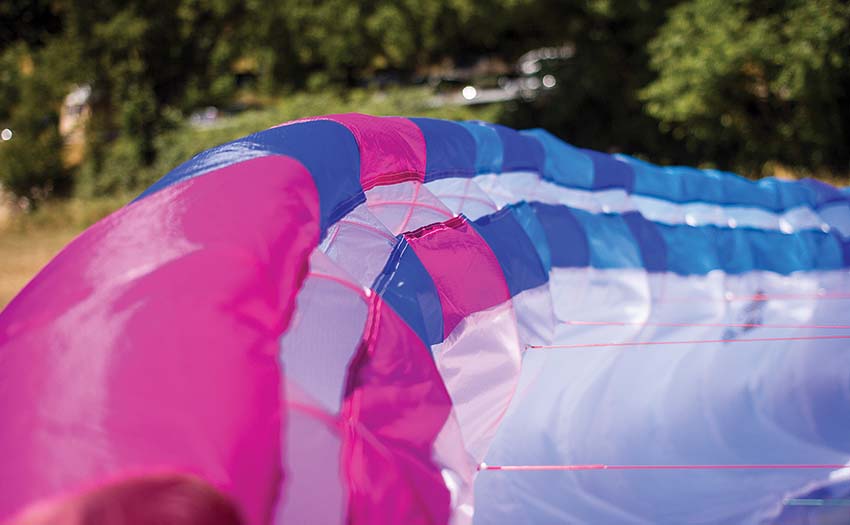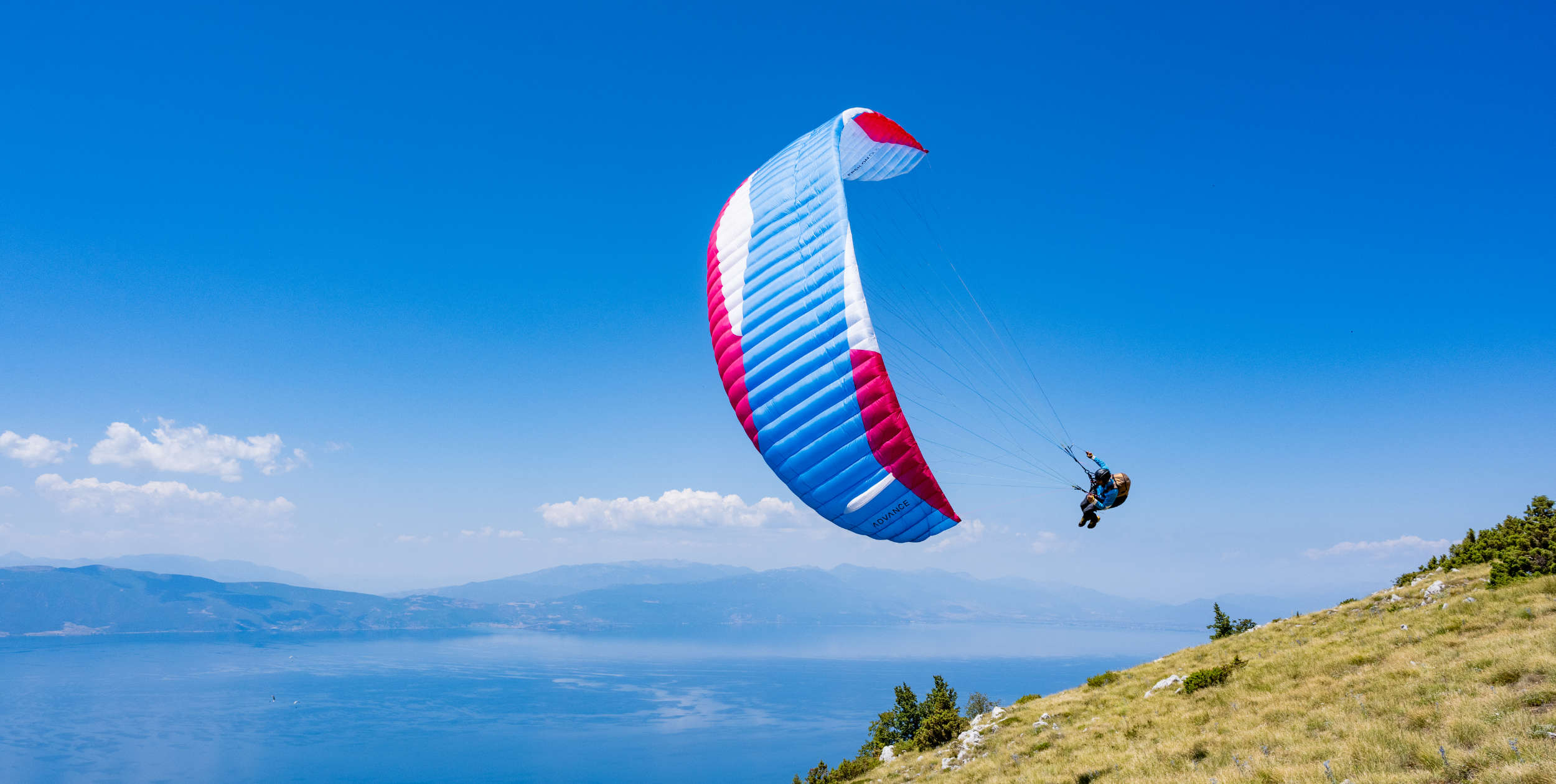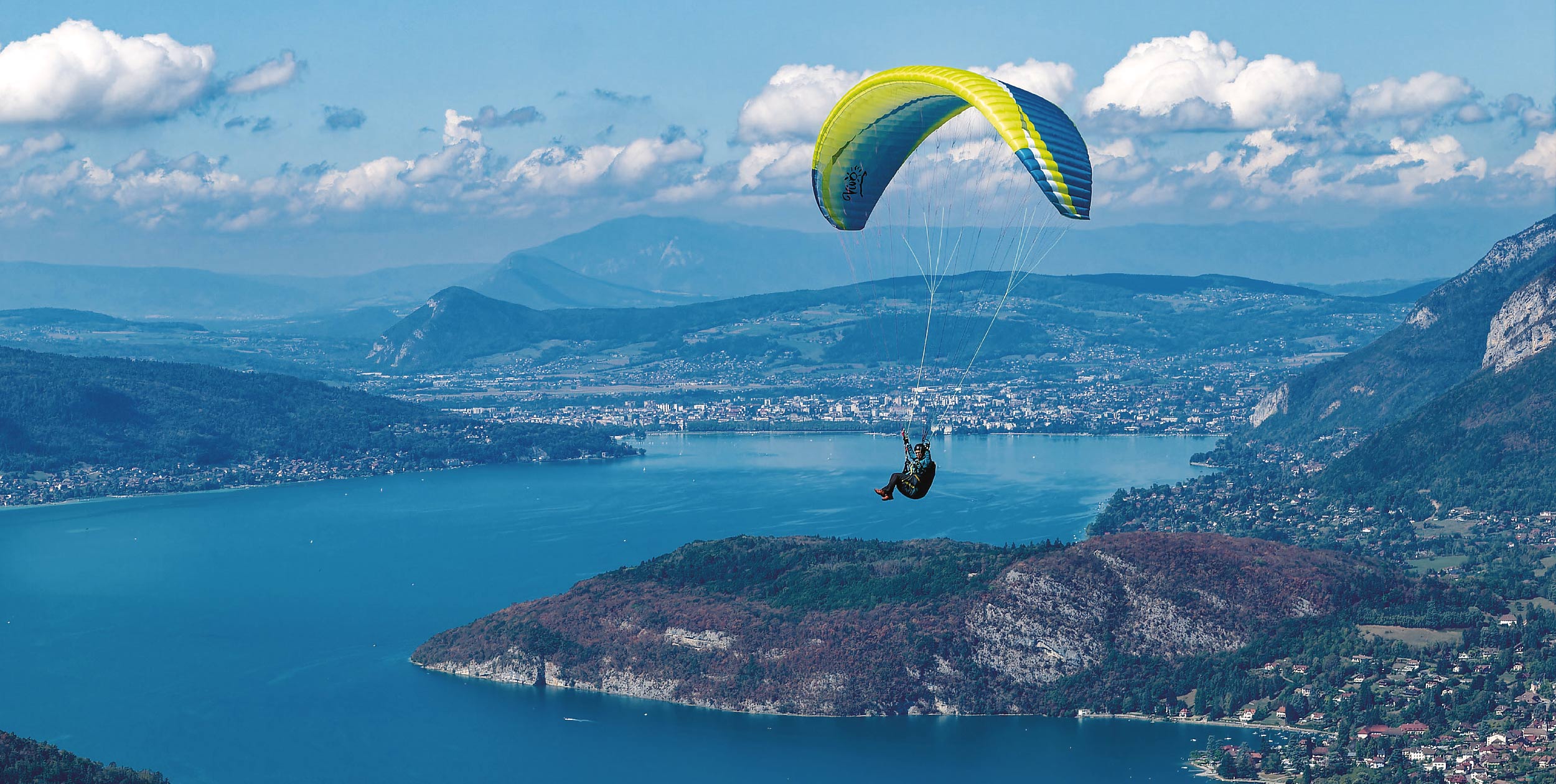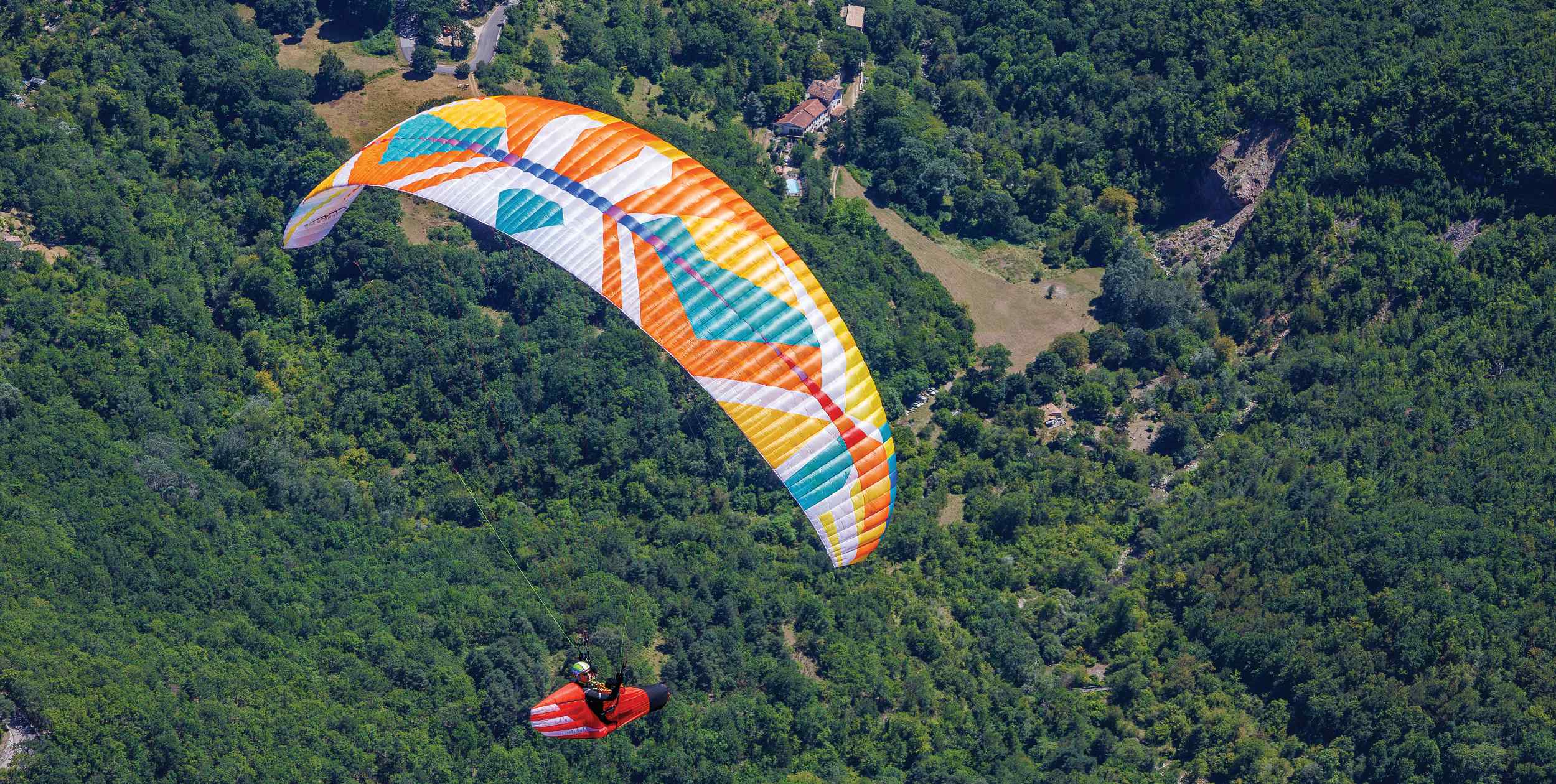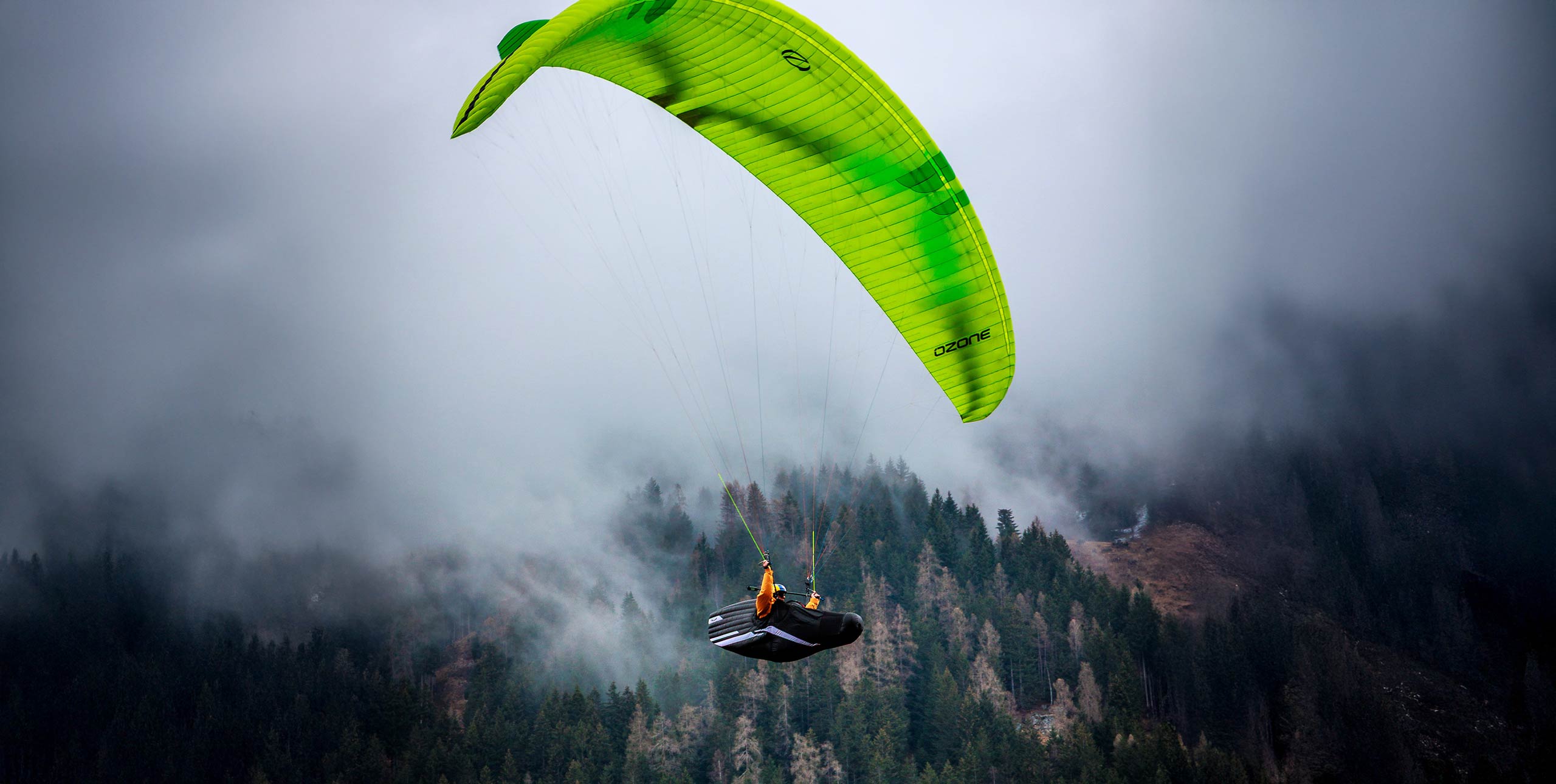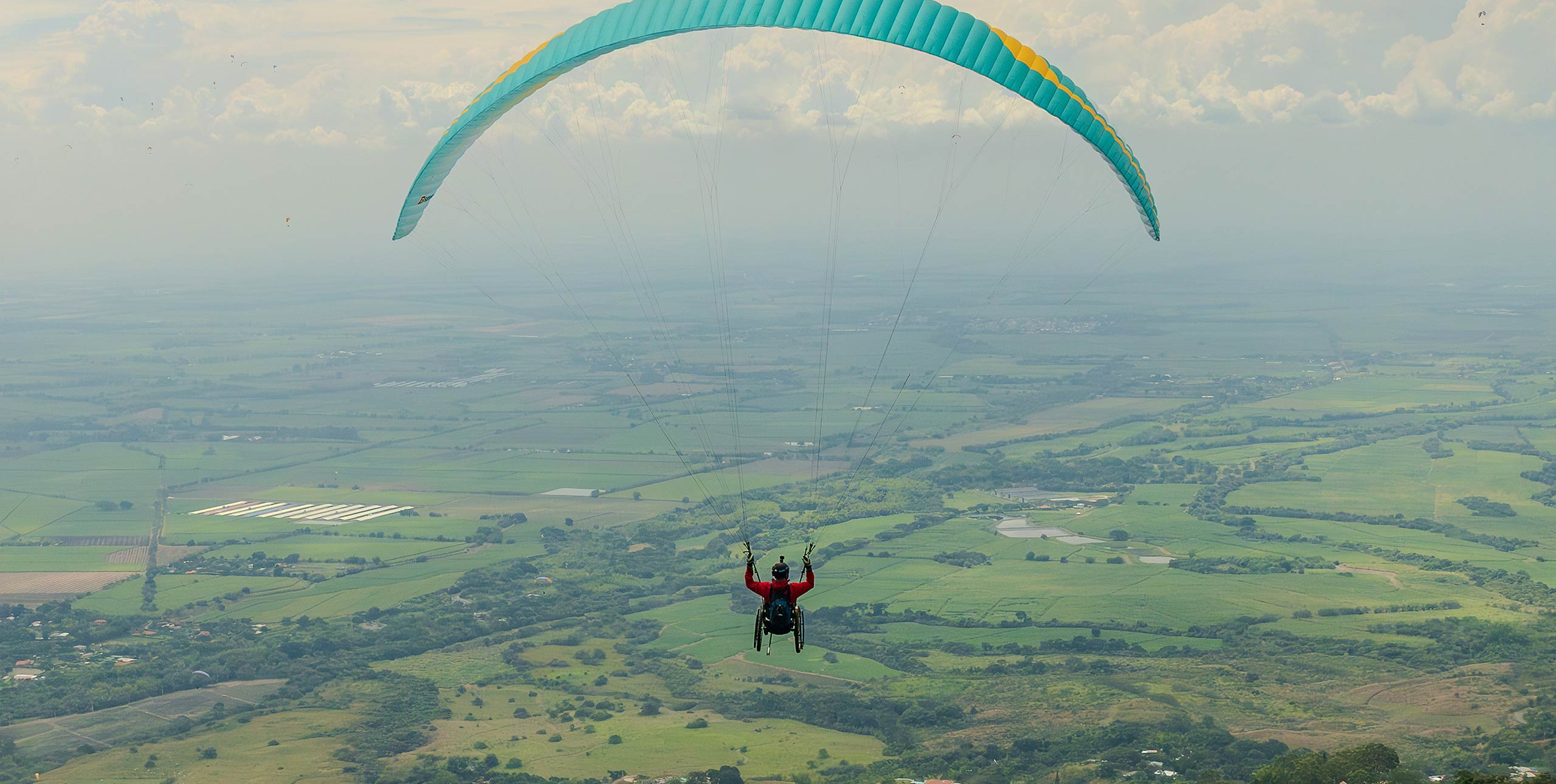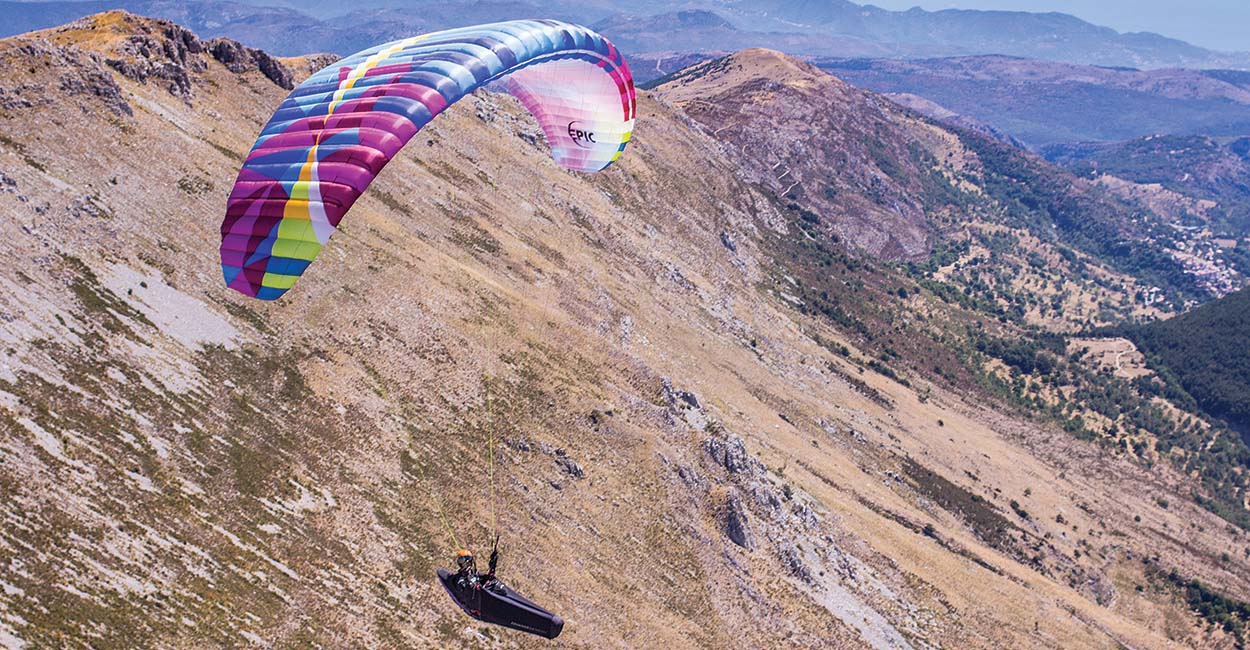
I FIRST GOT to fly the Epic from BGD at the Kössen Testival back in May. With great flying conditions, I took the chance to grab one of their demo wings to try it out. The cable-car whisked me up the mountain and after a short walk, I was soon unrolling the wing on the grass of the huge take-off area.
The new ‘shattered’ colour scheme is instantly noticeable when you unroll the wing. Made up of a series of triangles of various shades of colour it gives the wing a unique look but must add to the complexity of production. I had wondered if it would increase the weight but BGD’s Bruce Goldsmith told me it only adds around 30g to the total weight, a compromise they were happy to go with.
Having a three-riser setup and sheathed lines the wing is easy to sort on the ground. Made from 13mm webbing the risers are sporty looking. Brake handles are large and nicely padded, held on the risers with snaplocks that we have only seen elsewhere on speed wings. They have to be pulled slightly towards your body to release.
Despite some of my fellow pilots struggling with the fickle winds on launch, the Epic inflated smoothly and easily rose overhead, just as you would expect from this class of wing. Letting it accelerate, a short run saw me efficiently lifted into the air.
I had only my basic kit rather than water and the clutter I normally take when flying cross-country so was sitting squarely in the middle of the weight range of the ML wing – it takes an all-up weight from 90kg-110kg and I was flying at about 100kg. I was slightly concerned that this could give me rather boaty handling, but the first turn near the hill swept those worries away. I later discovered Bruce recommends flying the Epic around the middle of the weight range.
The wing is nice and agile and seems to retain energy well. That combined with a compact feel gives it a go-kart style whizzy feel that will have you smiling in minutes.

Design
Design-wise the Epic has a flat aspect ratio of 5.01, which puts it on a par with gliders such as the Ozone Buzz Z5 and the Nova Ion 4. The Epic has an “aggressive sharknose” and mini-ribs on the trailing edge. The sail uses Dominico D30 and D20 on the top and bottom surfaces with Porcher cloth used for the ribs.
In keeping with BGD’s design philosophy it has a lower cell count than its peers: 42 compared with the Buzz’s 48. It does though use BGD’s Chord Cut Billow (CCB) an alternative to the extra seams of 3D shaping on the top surface. The idea is that the extra seams run chordwise from the leading edge create 3D panels, “resulting in fewer ripples and improved rib profile shape and stability.” It’s a technology that is unique to BGD; Bruce says it causes less turbulence on the top surface of the wing compared with span-wise seams.
Climbing out
Out front didn’t seem to be working that well; this was, after all, a north face. Instead, I made use of the bubbles of lift coming up the ridgeline. Using the agile handling I could keep hold of them near the hillside and work my way up the crest as they rose behind the take-off towards the summit.
As I climbed I spotted a pilot to my left climbing well from a small into-sun face that was also rather in the lee. I decided to join them, flying through the strong sink expected on the lee to enter the rather rowdy climb. Now I’m not about to say the Epic didn’t need any pitch control, but it was certainly less than higher-class wings would need and the compact nature of the wing meant there was no flexing.
Wanting to stay in the core I used a bit more inner brake and plenty of weightshift to turn tightly and the wing reacted quickly, banking over nicely. If you are a bit heavy handed with the brakes it can dive in the turns; for efficiency it is better to make use of weightshift.
In strong climbs, the Epic gives you bags of control and, despite not being near the top of the weight range, I felt totally in control of the wing able to put it where I wanted. There was none of that sticking that you sometimes get trying to push into the stronger lift when light on a wing.
I flew a couple of times in windy conditions back in France and the wing seems to hook in nicely to thermals, giving you confidence when tight and low. On a couple of occasions people were struggling to get up in stable windy air and I was able to hook a thermal that took me straight up to the better air above with ease.
The wing also has quite a lot of roll, making it easy to bank when you want but making for quite a lot of movement when compared to some more sedate low EN-B wings. I really love this and I am sure many pilots will, but I know from feedback on previous reviews it isn’t to everybody’s taste.
However, this doesn’t mean it feels insecure. I felt very secure as the wing goes where you want it to and is nicely controlled in pitch. Generally, there are no big pitch movements in turbulent air and it reacts quickly to brakes if you do feel the need to control it.
In his introduction to the wing, Bruce says that he, “used an easy pitch profile and arc for a high degree of passive safety, allowing the pilot to concentrate on the flying.” It certainly feels like he has achieved that.
I flew the wing on a windy day back in France when maybe I should have just jumped back in the car. Instead, I had taken off saying “I’ll just fly home”. In the air the west wind was stronger than I had thought and I found myself drifting quickly with the first thermal. As I rose I realised it was actually coming slightly over the back so we had been in the lee. The wing though behaved itself, giving me enough feedback to feel the air and stay in the climbs without any nervousness that would have set the pulse racing and I was able to climb out.
Speed and glide
Back in Austria the strong climb had delivered me to cloudbase so it was time to head off and explore. The bar on the Epic is nice and light to use. Even at full bar it feels very solid and you can happily stay on it through mild turbulence.
Deploying my TAS speed probe I was able to measure a top speed of 50km/h at 100kg all up, which is pretty fast for this class. Trim speed is 39km/h. I was so surprised at this figure that I double-checked the calibration of my TAS. It was right, and flying alongside other similar level wings that little extra speed at trim was noticeable.
During my flights on the Epic it felt like best glide was achieved with a bit of acceleration, something Bruce said was borne out by their own tests. Having confidence in your accelerated wing is great for learning speed-to-fly and flying at the best speed for the conditions.
The wing is very pressurised, something you notice when you pull big ears. They are easy enough to do thanks to the extra riser, but want to pop out the moment you let up. I also found they could thrash around a bit. With speedbar applied as well they give a good descent rate and forward speed.
The internal pressure was also very noticeable when I tried pulling some asymmetrics. I found it pretty hard to get it to fold over nicely as you are meant to for the EN tests. More often than not, only the leading edge really collapsed, and then it just wanted to bang straight out.
Playtime
There is definitely a nice dynamic playful side to the Epic. Asymmetric spirals and wingovers are great fun on this wing and it is easy to build them pretty big. Using weightshift and brake I was above the wing on the second turn, but it felt easy to control. In this respect it is quite similar to the Icaro Gravis that we flew recently; both wings have the energy and handling to make them great for learning canopy control and some freestyle movements.
BGD’s test pilot Kārlis Jaunpetrovičs told me he was particularly pleased with how the wing handled negative manoeuvres such as spins and helicopters. Playing with the spin point in turns the wing has a nice progressive feel to it and no snappiness to catch you out.
Too much fun
After an evening flight messing about on the Epic where I climbed to the top of our local mountain, top-landed for the fun of it then played up high in the sky, I realised just how much fun I was having with it. It has such a reassuring feel combined with nice dynamic handling that you can’t help but have a smile on your face. It’s a little go-kart that you can throw into the curves and feel the Gs.
It’s also got XC performance: something that test pilot Karlis has proven with a flight of over 180km through the French Alps. The Epic then is a great all-rounder that you can hone your flying skills on. I’ve flown quite a few of Bruce’s wings over the years – I’m going to stick my neck out and say it’s probably his best.
****

And now the Echo…
The light version of the Epic is the Echo. The light version of the Epic is the Echo…o…o
For it, Bruce and the team have switched to lighter materials using Dominico D20 on the top surface and Porcher 27g/m2 on the bottom. The lineset uses the same layout as the Epic but lighter materials. It’s not a radical superlight version though and the lower lines are still sheathed making handling on the ground easy.
The riser set is the same as that used on the Epic with standard maillons. The ML size I was flying weighs 4.4kg, a 700g saving on the Epic, which weighs 5.1kg. This compares with the Nova Ion at 4.95kg in the same size and the Ozone Geo weighing 4.2kg for one covering a slightly lower weight range. The similarly sized AirDesign Vita2 Superlight saves an additional 400g but uses unsheathed lines, softlinks and lightweight brake handles.
As you would expect from a light version the inflation and handling on the ground is even better than the original. It just requires gentle pressure to bring overhead and if there’s any wind leaning back in the harness will see it float overhead.
In the air it’s very much the same playful character. Keeping it flat requires weightshift rather than deep brakes. If you want to play you can hit the brakes harder and it will bank up nicely. In the thermals there is just a bit more feeling in the brakes, but it is subtle and the behaviour in pitch is very similar.
Performance-wise BGD say the thinner lines have reduced the line area by 20%, giving the Echo the edge, especially when accelerated. We didn’t get the chance to make any direct comparisons in the time we had both wings so we will just have to take their word for that.
So which would I choose? For me I think the lighter version has sweeter handling, as is usually the case. There is additional performance, with no compromise on ease of use. It seems to be the obvious choice. Of course if you live and fly somewhere with particularly rough launches then the Epic will be the better choice as it will be harder wearing. Echo or Epic, a nice dilemma to have.
****
Manufacturer’s Specification
What BGD say: ‘The Epic is ideal for pilots about to leave their house thermal for the first time, and a fun all-rounder for seasoned pilots.’
Use: All rounder
Pilot level: intermediate pilots +
Sizes: XS, S, M, ML, L
Flat area (m2): 21, 23, 24.97, 26.83, 28.85
Certified take-off weight (kg): 50-65, 60-80, 75-95, 90-110, 105-125
Glider weight (kg): 4.2, 4.6, 4.9, 5.1, 5.4
Cells: 42
Flat aspect ratio: 5.01
Certification: EN/LTF B
flybgd.com
To stay up to date and read our reviews first, subscribe to Cross Country

